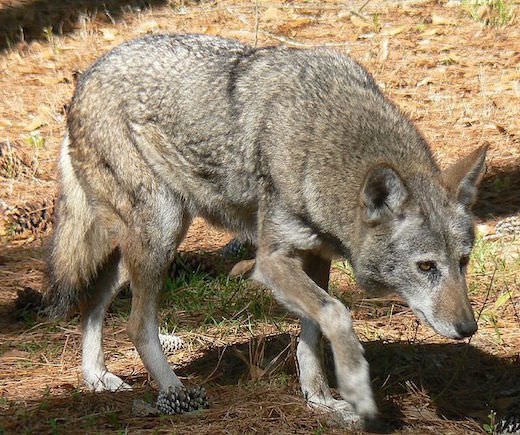Red Wolf

Critically endangered
The red wolf has a red tawny coat and bares physical similarities to both the coyote and gray wolf but is its own reproductively isolated species. The red wold is smaller, more slender and more long legged than the gray wolf. Primarily nocturnal, red wolves just like their gray counterparts are pack animals which communicate via scent, body posture, facial expressions and vocalization methods such as the styereotypical howl. However, the red wolf is otherwise a shy and reclusive creature and will often hunt either by itself or in smaller packs than other wolf variations. In fact, the red wolf hunting in smaller pack sizes may once have given the species an evolutionary advantage, as pack sizes are understood to be dependent on available prey populations. Like all wolves however, red wolf packs are governed by a hierarchy of dominant and subordinate animals. Reproduction takes place between an alpha male and a chosen female and red wolves are known to establish life long pair bonds.
Population Distribution
The historical range of the red wolf was considerable, encompassing Florida, Texas, Missouri, Pennsylvania and Ohio. Preferring bushy and forested areas as well as coastal prairies, red wolves were once a dominant predator of rabbits, deer, prarie chickens and cottontails. Moreover, for a substantial time the red wolf lived relatively peacefully alongside mankind due to a Cherokee belief that killing a red wolf would inspire retaliatory killings of humans by its surviving pack mates. At present however, wild red wolves inhabit only isolated areas in the Smokey Mountains, Florida, North Carolina and South Caroline respectively, where red wolves have been reintroduced via captive breeding programs. The sucsess of these programs however, is still arguable.
Threats
A 2007 US Fish and Wildlife Service report suggested that there were only 300 red wolves left in the world with 207 of this number being in captivity. Since this time it has been estimated that there may be between 100-150 wild red wolves living in North Carolina alone, however, reintroduction schemes are threatened by red wolf populations seemingly interbreeding with coyotes. Habitat fragmention and the isolation of reintroduced red wolf populations is also considered a threat to the species as this makes the red wolf more susceptible to disease and both immediate and long term health problems brought about by interbreeding. Climate change caused storm surges and flooding are also considered to threaten the continued existence of the red wolf due to the low elevation of many of the areas where the species has been reintroduced. Negative human attitudes toward the species, further human development of red wolves' already limited habitat and a significant number of red wolf deaths brought about each year by motor vehicle accidents are also acknowledged as posing significant threats to the species' survival. There are however, various organizations including the US Fish and Wildlife Service which are determinted to attempt to save the species. Moreover, 30 US facilities are presently involved with on going red wolf reintroduction efforts.